5 Things the Jurassic Park Franchise Gets Wrong (and 3 it Gets Right)
5 Things the Jurassic Park Franchise Gets Wrong (and 3 it Gets Right)
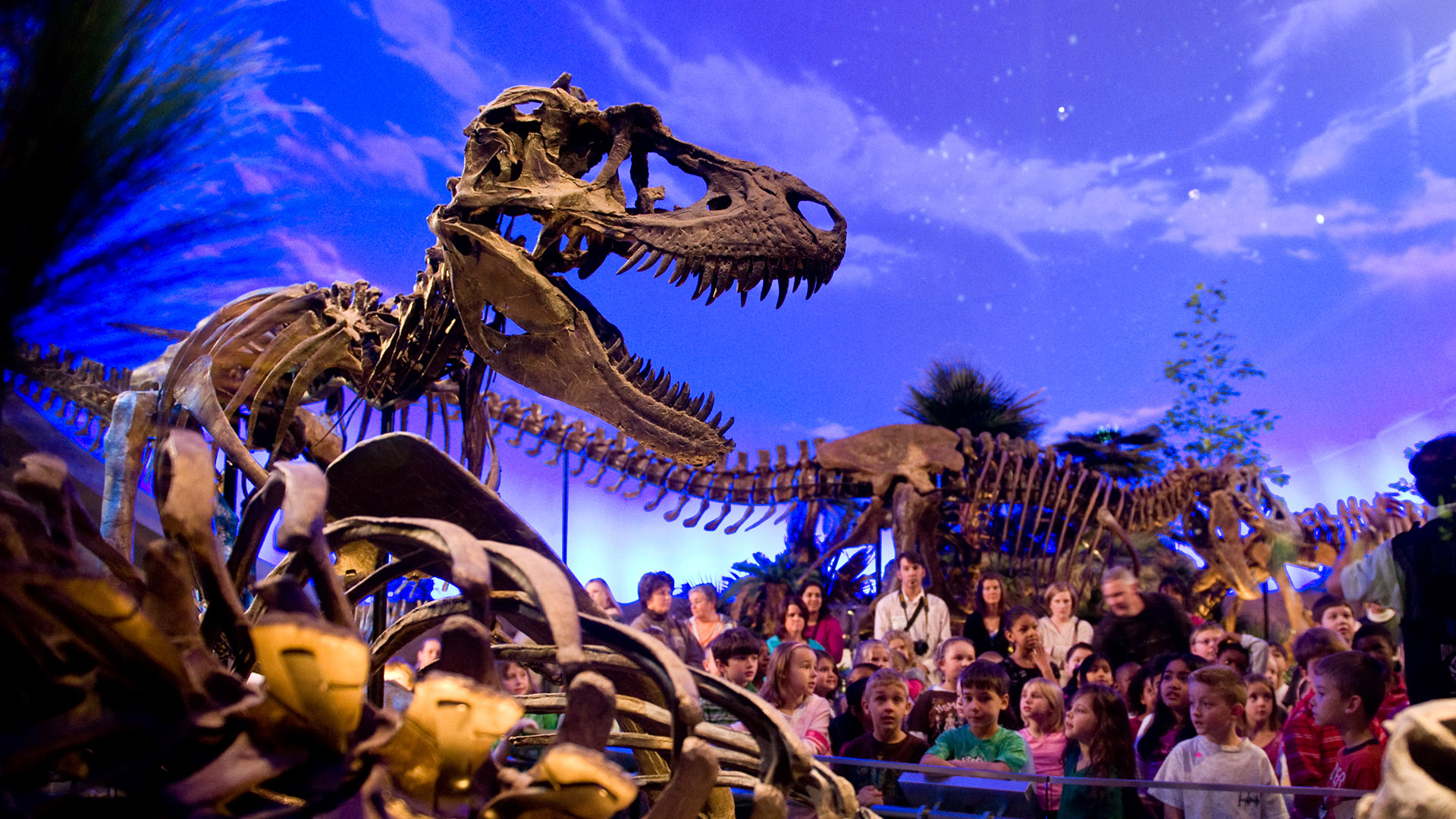
When Jurassic Park roared its way to the top of the box office in 1993, it raked in almost a billion dollars in worldwide ticket sales when all was said and done. The special effects were mind-blowing. Watching a Triceratops, Brachiosaurus, and a galloping Gallimimus herd come to life on the big screen was a seminal moment in cinematic history. And let’s not forget the real star of the show, Tyrannosaurus rex. This massive carnivore struck fear in the hearts of many moviegoers.
Jurassic Park sparked a renewed interest in paleontology—the branch of science that focuses on ancient life by looking at fossils. After three decades and two film trilogies, Jurassic Park continues to inspire people to dig in and learn more about these animals who roamed the Earth millions of years ago.

Now that the final installment of the Jurassic Park/Jurassic World series has been released, we talked with our Paleo Team about the series. What does the film get right? What does the film get wrong? Here’s what they had to say.
“Whenever I come to a Jurassic Park movie, I always come with the understanding that this is really a monster movie. You don’t come for the science,” Paleontology Curator Laura Rooney said. She also explained that these films still give our paleontologists an opportunity to “nerd out about dinosaurs.”
So let’s “nerd out” with them.
5 things the Jurassic Park series gets wrong about dinosaurs
1. Dinosaurs did not roar
That climactic scene at the end of the original Jurassic Park where the T. rex rears its head and lets out a deafening roar while that banner falls to the floor? Our paleontologists say it wouldn’t have happened that way.
Why?
Because dinosaurs did not roar.
How do we know?
"We're never going to know for sure certain things about these animals,” Laura explained. So we have to make conjectures and draw conclusions from their ancestors and relatives in the modern world—birds and crocodiles. As you know, birds and crocodiles don't roar. Birds chirp, tweet, and coo. The closest dinosaurs might have come to a roar is something similar to the rumble of a crocodile.
.jpg)
Sheba_Also 43,000 photos, CC BY-SA 2.0, via Wikimedia Commons
Science is about following the evidence. And the evidence has led scientists to conclude that dinosaurs did not roar. That certainly changes that final battle scene, huh?
But don’t worry, Jurassic Park. Most dinosaur movies get this wrong.
2. Dinosaurs probably didn’t spit venom
It’s a terrifying scene. A Dilophosaurus corners its prey. Giant frills open on their neck. The Dilophosaurus spits a sticky, venomous goo in the prey’s face, rendering their prey blind. The end is nigh.
_(8692622586).jpg)
Matt from Melbourne, Australia, CC BY 2.0, via Wikimedia Commons
It makes for a great movie scene (or two), but it’s a work of fiction. “No evidence shows that they spit an acidic venom that would blind its prey,” said Lead Preparator Jessica Taylor. “No rattling neck frill that shakes, either.”
3. We can’t make dinos from ancient DNA (aDNA)
In the film series, the creation of the dinosaurs was based upon the idea that a fossil of a blood-sucking insect could contain preserved blood from a dinosaur. Extract the blood. Get some DNA. Fill in the gaps with frog DNA. And…voilà! You’ve revived a prehistoric creature.
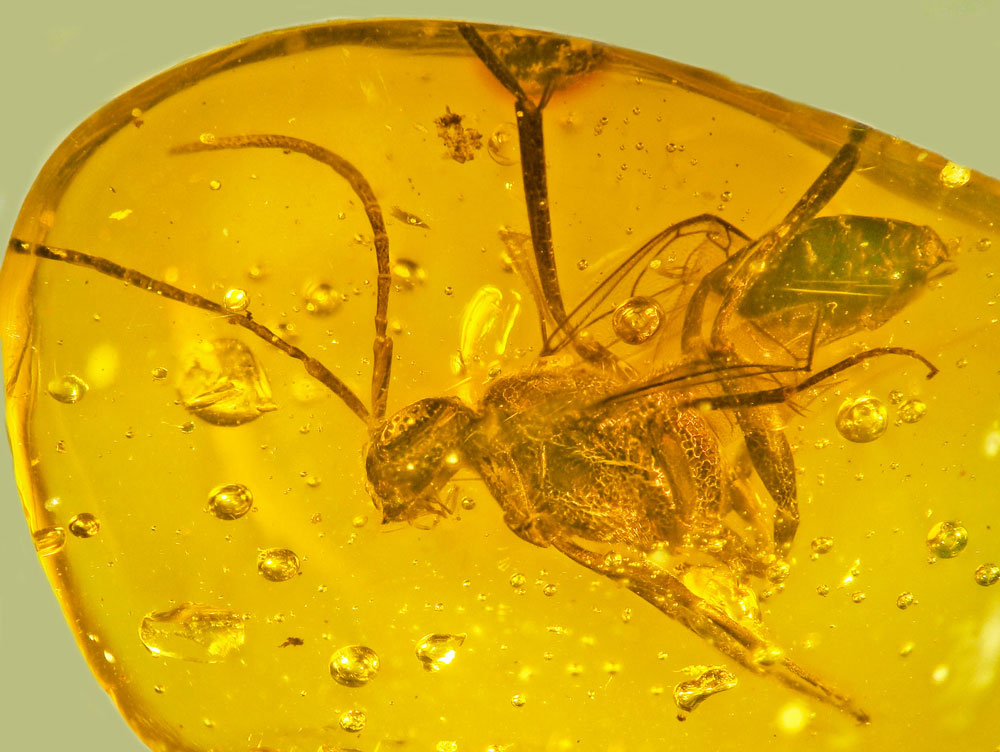
Oregon State University, CC BY-SA 2.0, via Wikimedia Commons
Sounds simple enough.
There’s a catch, though. We can’t get aDNA that is that old. “The oldest confirmed DNA,” said Lead Paleontologist Dr. Jennifer Anné, “Are from around 1 million years ago, and those are DNA fragments, nothing close to what you would need to actually clone an animal.”
The Jurassic Period ended 145 million years ago. You can do the math. That’s a long time.
So you’ll have to put your dream of having a pet Ankylosaurus to bed.
4. Raptors were much smaller in real life
It’s true. Raptors were much smaller than they are portrayed in the films. In fact, most of the animals in the Jurassic Park films are too big. Perhaps it’s just some dramatic license taking place? After all, we already know these movies aren’t documentaries.
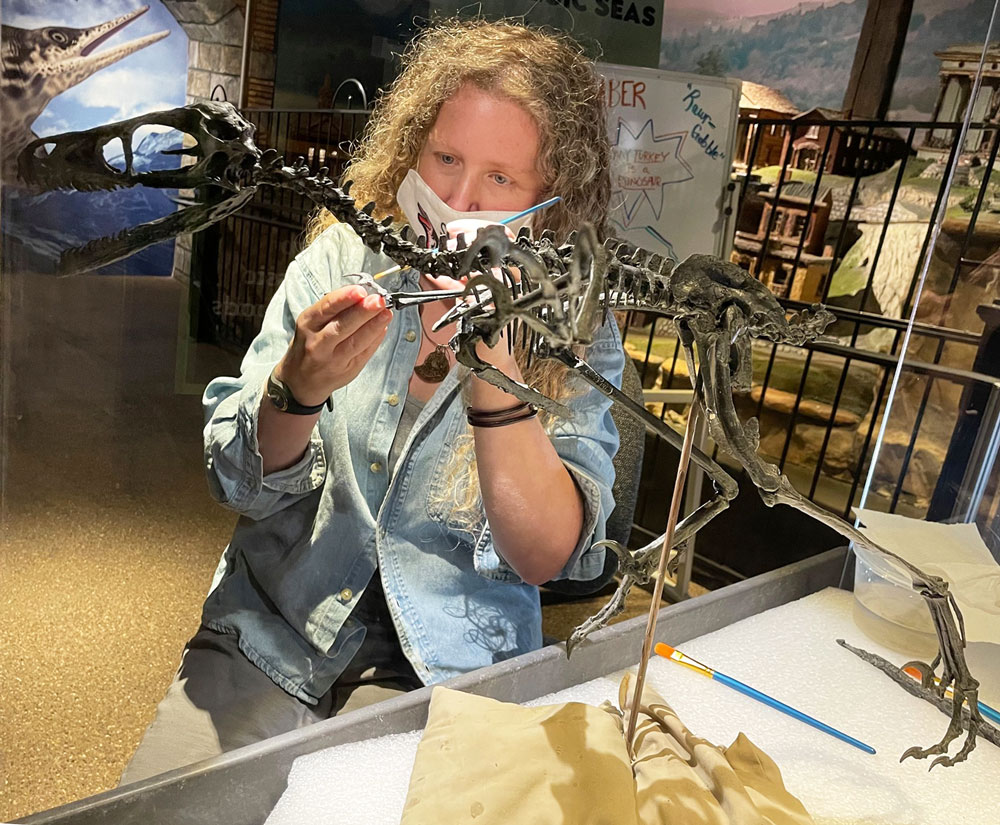
Dr. Anné cleaning the Bambiraptor specimen that is on display in Creatures of the Cretaceous™ inside the new Dinosphere®.
5. Speaking of raptors…
Raptor hands and wrists are all wrong in the films.
“The wrists should be oriented so the palms face each other,” Laura said. The way they’re shown in the films turns these poor raptors into dino zombies.
Dino zombies. Now there’s an idea for a new film series…
3 things the Jurassic Park films get right
We’ve spent a lot of time pointing out the errors in the Jurassic Park franchise, but there are several things that the trilogies have gotten right over the years.
1. Endothermic (warm-blooded) dinosaurs
In the Jurassic World trilogy, dinosaurs are doing fine outside in a snowy environment. This on its own doesn’t mean that the dinosaurs in the films are warm-blooded. There is evidence that some dinosaurs had to deal with snow. And we see some modern reptiles are able to survive in cold environments, even though they’re cold-blooded creatures.
But then you look at the dinosaurs’ breath. In the snowy environments, you can see their breath in the cold. And there’s another scene where a Velociraptor’s breath fogs up some glass. These are tiny details that lead our paleontologists to conclude that at least some of the dinosaurs in the Jurassic Park/World films are accurately portrayed to be warm-blooded animals.
2. Pterygoid teeth
Although it’s not a dinosaur, Dr. Anné’s “Favorite ‘nerd’ moment is in the Mosausarus. They actually made sure to include the pterygoid teeth, which are a second row of teeth on the pallet. You can really see them in the first Jurassic World movie when it comes up to get the shark."
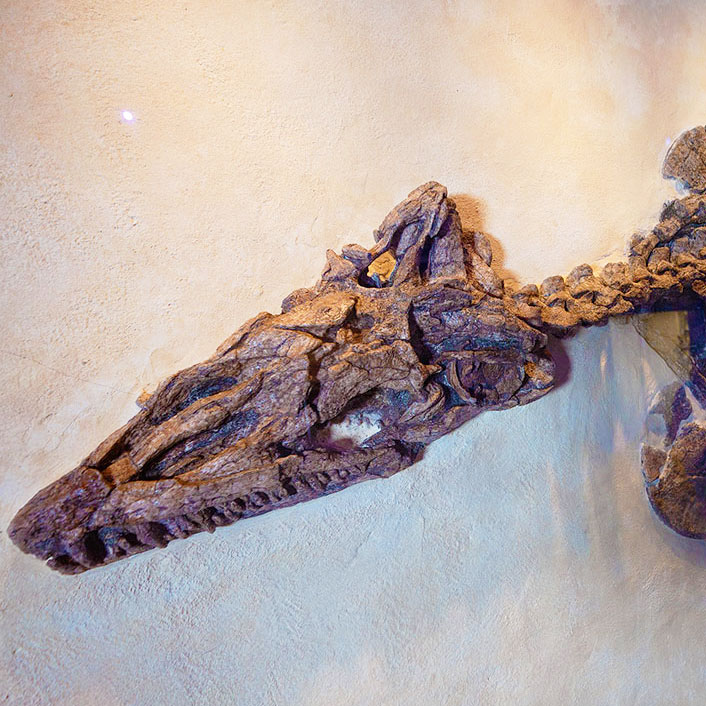
Close-up of the Plioplatecarpus—a type of mosasaur—on display in Monsters of the Mesozoic Seas™ inside the new Dinosphere®.
3. Feathered dinosaurs
“Many people are excited that they finally put some feathers on dinos,” Dr. Anné’ explained. “They don’t do it for near enough dinosaurs. There should be a lot more with feathers. But at least they started putting them on some dinos.”
Wait.
Feathers?
On dinosaurs?
Yes! That’s what the evidence has been telling paleontologists. Birds are believed to be direct descendants to theropods—carnivorous dinosaurs like the Allosaurus, Gigantosaurus, and T. rex. “We’ve learned a lot of information over the last 30 years, because science never stops,” Laura said. “The more we learn about them, the more we’ve seen a connection to birds.”
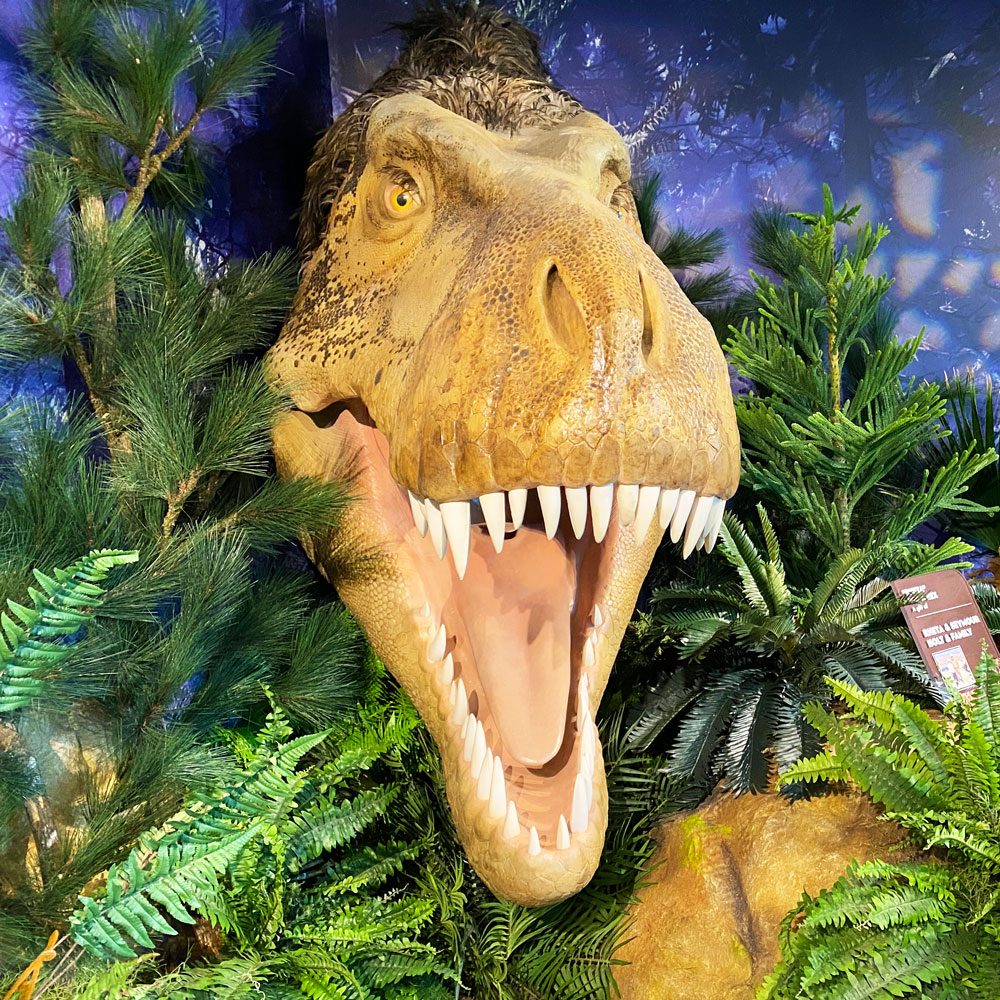
Rheta, the sculpture of a feathered T. rex head greets visitors in the entrance to the new Dinosphere®.
You can talk to our paleontologists in person
Do you want to know more about how accurate (or inaccurate) dinosaur films are? Maybe you’d like to hear stories about their digging expeditions along the Jurassic Mile® dig site in Wyoming. Or maybe you’d like to see what fossils they’re currently working on.
You can do it all when you visit the R.B. Annis Mission Jurassic Paleo Lab and the Polly H. Hix Paleo Prep Lab inside Dinosphere®. Because science never stops, Mission Jurassic™ keeps going during the summer dig "offseason." Our paleontologists are busy researching, exploring, and discovering amazing things about the prehistoric world. And they are excited to share these amazing creatures’ stories with you.

Then, after you’ve met our paleontologists and dug into the fossils on display, try your hand at creating paleo art in the Dinosphere Art Lab. Who knows? Maybe your creations will inspire a post-Jurassic World generation of paleontological pursuits.









